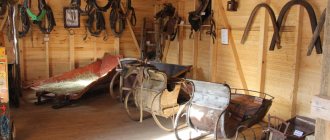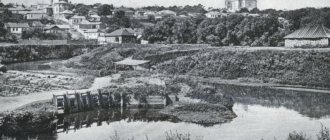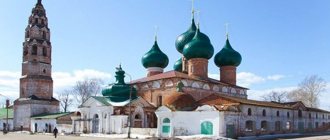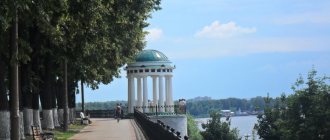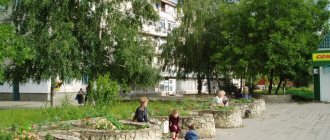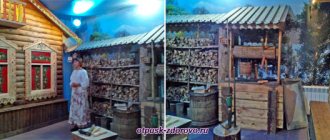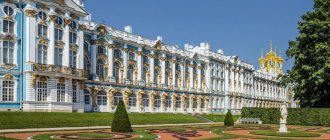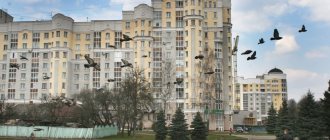Poshekhonye: TOP-3 things to see in one day
To see all the sights, you need to stay in Poshekhonye for several days. If tourists visit this city “passing through,” then they should devote time to the best and most interesting places.
Holy Trinity Cathedral
- Address: Freedom Square.
Trinity Cathedral is the oldest stone structure preserved here. It was built in 1717, long before Poshekhonye was renamed into a city. Thus, the temple can be considered older than the city itself. The cathedral is made in the style of Russian architecture. The core of the composition is an expressive quadrangle, crowned with five chapters.
The drum of the central head is light, the rest are deaf. The cathedral is adjacent to a rectangular refectory and three apses. The building is decorated with a jagged cornice and semicircular kokoshniks. During one of the reconstructions, the lower windows and arches were chipped, which is why the original appearance of the building was partially lost.
In the second half of the 19th century, a four-tier bell tower was erected next to the temple, which in many ways resembles the destroyed Yaroslavl cathedral bell tower. The lower tier is richly decorated with kokoshniks and half-columns. The second and third are massive, decorated with carved arches and pilasters. They serve as the basis for a rotunda topped with a dome hemisphere.
Located in the city center, the cathedral has long been a high-rise dominant feature. During the Soviet years, a fuel oil factory settled in it, and the bell tower was used as a water tower. Industrial exploitation led to the destruction of the original interiors.
During the restoration, workers literally had to carry out fuel oil in buckets. None of the frescoes survived; the altar was destroyed. Today, the building has been returned to its original appearance, and work is underway to create new interiors. Despite the continuation of work, services are already being held in the temple.
Museum "Toptygin House"
- Address: Sovetskaya st., 4A.
“Toptygin House” is a museum dedicated to the owner of the Poshekhonsky forests - the brown bear. It was opened in 2008 and since then has been one of the most visited attractions in Poshekhonye.
In the museum you can look into a bear's den and sit in a hunting shed on a tree trunk, as well as look at stuffed brown bears.
Children will be interested in visiting the teddy bear hall. Here are toys from the beginning of the last century, the Soviet era and modern ones. Many of the cubs were donated by city residents. Each toy is a piece of childhood that holds warm memories.
In addition, in the museum you can see paintings, books, and objects of decorative and applied art related to bears.
Games, master classes, and exhibitions of fakes add variety to the excursion program. At the end, tourists will be offered to drink tea from a samovar and taste fragrant honey.
City Park
- Address: pl. Freedom.
The city park is the most popular place for walking in Poshekhonye. This is an island of peace and tranquility, in the middle of a sea of city bustle. The park has an ancient birch grove with walking paths running through it. Here you can find both ecological trails and asphalt paths convenient for cyclists and mothers with strollers.
The park occupies a picturesque corner on the banks of the Sogozha River. On one side of the birch grove there is a bridge across a narrow section of the river. You can cross the bridge back to the city. On the other side, the park overlooks the embankment, which offers an impressive panorama of the river valley. Visitors to the park note its well-groomed and cleanliness. On its territory there is a memorial complex dedicated to the heroes of the Great Patriotic War.
The most interesting museums in Poshekhonye
There are various museums in Poshekhonye and the surrounding area. Among them there are typical historical centers and unusual exhibitions that tourists have never seen before.
People's History and Local Lore Museum
- Address: Lyubimskaya st., 20A.
The Poshekhonsky Museum of Local Lore is called a unique phenomenon of provincial culture. It was founded by citizens in 1974 to preserve culture and pay tribute to history.
Through the joint efforts of the Poshekhon residents, a collection of more than four thousand exhibits was assembled. The exhibition occupies several halls, each of which is dedicated to a special topic:
- primitive history of the region;
- history of XX and modern times;
- city life;
- crafts and trades;
- Poshekhonsky flax;
- Great Patriotic War;
- the world of plants and animals.
The Museum of History and Local Lore not only preserves the memory of ancient traditions, but also passes on folk skills from generation to generation. It has creative studios where children and adults are taught Gayutin painting, rag weaving, weaving, dancing and singing.
Museum "Vodyanoy's Residence"
- Address: Sovetskaya st., 2.
Poshekhonye stands on five rivers, which is why it was given the nickname “Yaroslavl Venice”. And in the river city, according to Slavic legends, Vodyanoy should live.
Vodyanoy “lives” in the children's library. In the room you can see numerous portraits of the owner, figurines of his frog friends, a water mill, an aquarium with live catfish and other attributes of the underwater world.
Children will especially enjoy this museum. The guide plays the role of Vodyany himself, and “Kikimora Bolotnaya” helps him. Together they give instructions, tell stories, sing songs, and at the end they treat the tourists to fish soup.
Museum "Soviet Rus'"
- Address: Poshekhonsky district, Yasnaya Polyana village.
The museum operates at the House of Culture of the village of Yasnaya Polyana. This is a kind of time machine that takes visitors back to the years of October pioneer childhood and Komsomol youth.
The halls are lined with shelves of old books, decorated with red banners, portraits and busts of Lenin. A soda machine, a school uniform, a briefcase, a pioneer bugle and toys will remind you of your childhood.
A ceremony of acceptance into pioneers is played out for visitors, in which anyone who wants to remember an exciting episode from childhood can take part.
Toptygin house
Bearish angle
Poshekhonye is the homeland of bears. In Poshekhonye, the Bear Corner project was launched in 2007. There are very dense and impassable places here, so they say that most of the bears in the Yaroslavl region live here. Hunters helped create this unique exhibit. Many materials were brought from the forest. According to the descriptions and advice of hunters, the den was reproduced in its natural form. So now the museum contains not only the bear, but also its natural home. In the local museum, which already has an interesting exhibition, because it has the status of a historical and local history museum, they first built a bear den. There was great interest in bears and their dens, so the Bear Museum, “Toptygin’s House,” was quickly opened in Poshekhonye. This is a fun museum where you can see bears, hear hunting tales and stories about a meeting between a man and a bear, about the process of making storage sheds, feeding the bear with oats, about the strength and caution of this animal. In one of the halls dedicated to the nature of Poshekhonye, there are samples of plants, stuffed animals and birds characteristic of this region. .. Everyone can take a photo next to the den and listen to stories about real bear hunting, its rules and features. This exhibit is the only one of its kind in the Yaroslavl region and in Russia. Taking into account the interests of the youngest visitors, the museum plans to organize puppet shows based on Russian folk tales. Adults will be able to learn about the habits of these animals, their lifestyle and hunting rules. The museum organizers also plan to open a “Sweet Shop”, where after the excursion visitors will be able to treat themselves to honey, jam, and traditional Poshekhon gingerbread.
Cultural attractions in Poshekhonye
Cultural and leisure centers will be of interest to lovers of theater and concerts. The festive atmosphere and creative atmosphere will give the evening a special touch.
Inter-settlement cultural and leisure center
- Address: st. Preobrazhensky, 1.
The cultural and leisure center occupies a former public meeting building. It was built in the second half of the 19th century. In those days, the first floor was occupied by an iron goods store and the grocery store of merchant A.F. Krundyshev, and on the second floor there was a public meeting hall and some of the city government services.
Today, the building hosts classes from 30 creative studios, as well as performances by the folk theater and the Sogozhanochka song and dance ensemble.
The institution organizes children's performances, music concerts, creative competitions, as well as holidays and open-air folk festivals. The structure also includes a children's amusement area with trampolines, electric cars and carousels, which operate in the summer.
Cinema "Yubileiny"
- Address: st. Preobrazhenskogo, 23.
The Yubileiny Cinema is one of the best cultural and leisure establishments in Poshekhonye. Every day (except Mondays) townspeople come here to spend time watching the latest Russian and foreign cinema. In addition, the cinema organizes educational events and celebrations for schoolchildren. On summer evenings, music concerts are held on the square in front of the cinema.
Yasno-Polyansky House of Culture
- Address: Poshekhonsky district, Yasnaya Polyana, Rybinskaya, 18.
The House of Culture is firmly connected with the history of the small beautiful village of Yasnaya Polyana. It was founded in 1930 as a country club and occupied premises in an abandoned church. Over the many years of its existence, the club moved from place to place, changed leaders, expanded and became more and more popular. In the 1980s it was renamed the House of Culture.
The institution's repertoire changed as Russia's ideals changed. After Perestroika, events dedicated to the history of the Soviet Union became a thing of the past and productions based on foreign works, as well as adaptations of books banned during the Soviet years, became a thing of the past.
The House of Culture continues to keep up with the times, but does not forget its origins. There is a museum dedicated to the Soviet era, and many productions tell about the history of the village. The House of Culture can safely be called the guardian of the culture of the village of Yasnaya Polyana. That is why it is so dear to local residents and interesting to their guests.
Poshekhonye - the birthplace of the Russian joke
Poshekhonye is considered the birthplace of Russian jokes. Here, as in the Bulgarian city of Gabrovo, all sorts of absurdities are happening. Interest in the image of the eccentric poshekhon
arose in Russia a long time ago.
It all started with folklore, Russian culture of the early 18th century. Naive Poshekhontsy climbed a Christmas tree to see Moscow, caught the sun with a basket, got lost in three pines, wove bast shoes the size of a boat and at night got tangled in their own feet. In 1798, Vasily Semenovich Berezaisky’s book “Anecdotes of Ancient Poshekhontsy”
. In 1821, the year of the death of the book’s creator, its second edition was published under the title “Anecdotes, or Merry Adventures of the Ancient Poshekhonians,” and the next one was published in 1863. The main object of Berezaisky's irony and ridicule was ignorance and stupidity. The type of “cheerful poshekhonets” created by Berezaisky established itself in Russia, was popular and existed in popular prints until the present era. XX century. It’s safe to say that the Poshekhonians themselves “had a hand” in these jokes, for whom it was profitable to pose as klutzes, from whom there was nothing to take.
The work of the outstanding Russian satirist M.E. is associated with the Poshekhonsky region. Saltykov-Shchedrin, who himself had never been to Poshekhonye. The image of the anecdotal Poshekhons was used and reinterpreted by the writer in his works “Poshekhon Stories” of 1884 and “Poshekhon Antiquity” (1887 - 1889). The image of Poshekhonye, created in the works of Saltykov-Shchedrin, is collective. Under the name Poshekhontsy, the satirist brings out ignorant, narrow-minded and tough people, especially feudal landowners, and he turned a purely folklore motif into a powerful satirical image.
The eccentric Poshekhons are currently literary characters from Vasily Berezaisky’s book “Anecdotes of the Ancient Poshekhons,” written more than 200 years ago. Indigenous Poshekhonians and guests of the city meet Poshekhon eccentrics in the country of Poshekhoniya and play games with them based on jokes about the ancient Poshekhonians. Over the course of 2 years (2009-2010), the Poshekhon eccentrics became a recognizable tourist brand. The collective image of the efficient Poshekhon peasants won the genuine interest of local residents and guests of the city.
Presentation Poshekhons-eccentrics
Architecture of Poshekhonye: the most beautiful buildings
Walking around Poshekhony, it’s hard not to notice ancient buildings that attract attention with their age-old beauty.
Shopping arcades
- Address: Freedom Square, 3A.
Shopping arcades are the “calling card” of many provincial cities in Russia. Poshekhonye is no exception. The local shopping arcade was built in the 1830s and remains in excellent condition.
The architectural ensemble consists of two identical buildings, designed in the form of covered galleries, located parallel to each other.
In the old days, the ensemble included a third wooden building. Today, the shopping arcades serve the purpose for which they were built centuries ago: they house food and textile shops.
Zemstvo government building
- Address: Lyubimskaya st., 18.
The building of the zemstvo government was built at the end of the 19th century. This is a brick building in the eclectic style with pronounced features of classicism. Decorative elements include whitewashed window niches, frieze, pediment and towers. This is one of the largest public buildings in Poshekhonye.
The first floor of the building was occupied by the zemstvo library, office, archive of documents, offices of secretaries and the chairman of the council. The second floor housed a courtroom and a meeting room. Today municipal institutions operate here.
Sveshnikov's store and city government
- Address: st. Preobrazhensky, 2.
The white stone building in the eclectic style was built in the second half of the 19th century. The first floor is designed modestly, without decoration. The pharmacy store of the merchant Sveshnikov was located here. The second floor is distinguished by the stylish design of window niches and a frieze with a geometric pattern.
On the second floor there were city and town government, as well as a bank. Today the building is used in almost the same way: the first floor is occupied by a pharmacy, and the second floor by the city administration.
Women's gymnasium buildings
- Address: Proletarskaya st., 16.
In 1897, through the efforts of teacher E.S. Stoikova opened a women's gymnasium in Poshekhonye, which soon transformed into a gymnasium. Initially, the establishment was located in a wooden building, and in 1907 it moved to a new brick building.
Both buildings have survived to this day. The wooden and brick buildings were connected by a passage, which was decorated with a belfry in 1911. This element is missing.
In 1931, the complex was occupied by a collective farm youth school, which operated for four years. In 1935, a secondary school opened in its place. Currently, both buildings are occupied by a correctional boarding school.
Men's school building
- Address: st. Embankment of the Pertomka River, 9.
One of the most beautiful buildings in Poshekhonye is located on the embankment of the Pertomka River. It was erected at the end of the 19th century. The white stone house, decorated with a pediment with a colonnade and medallions, was built as a residential estate, but was later purchased by the city authorities.
It housed a men's school with a three-year education. During the Soviet years, a hospital was located here, and now there is a kindergarten.
Hotel of the Shalaev merchants
- Address: Freedom Square, 8.
A stone building with a half-tower topped with a dome and a spire catches your eye from a distance. At the beginning of the 19th century, it was occupied by a hotel opened by the merchant Shalaev. In the middle of the century the building became city property.
Since 1866, it housed a district court, and later a pedagogical institute. Today, the former hotel also serves the needs of the townspeople and houses the Education Administration Center.
Pharmacy house of Zhuravovich
- Address: st. Preobrazhenskogo, 19.
The two-story house in the constructivist style was built in the first third of the 19th century. There was a private pharmacy and hospital rooms here. Now the building is occupied by an art school.
"Russian Atlantis"
The vastness of the Rybinsk Reservoir
From the city of Poshekhonye, our path lies to the man-made sea. The Rybinsk Reservoir - an artificial sea - was created on the Volga River and its tributaries Sheksna and Mologa. April 13, 1941 at 13:00 10 minutes later its filling began. About 17 thousand years ago, there was a glacial lake on the site of the Rybinsk Reservoir. Gradually it became shallow, and a vast Mologo-Sheknistaya lowland arose. The Rybinsk reservoir was planned to be the largest artificial lake in the world by area. Construction of the Rybinsk hydroelectric complex began in 1935 near the village of Perebory. in the fall of 1940, the Volga riverbed was blocked. Filling the giant bowl lasted 7 long years. The average depth is 5.5 m, the maximum is 25-30 m. The following are flooded: forests, 663 villages, 1 city (Mologa), 6 monasteries and more than 50 temples. 130,000 people resettled. At the bottom of the Rybinsk Reservoir lie villages, cemeteries and even entire villages with churches. But during low water, church crosses appear above the surface of the water. Mostly such underwater villages are located near the Poshekhon and Breitov shores. After filling the giant bowl, an eighth of the Yaroslavl land went under water, including precious water meadows, the grass of which was not inferior in quality to the grass from alpine meadows, arable land, and pastures. Thousands of hectares of mushroom and berry forests. Agricultural production in the region suffered a severe blow, because... Mologsky and Poshekhonsky districts were the main areas of oil production. This is a kind of “Russian Atlantis”... Of course, the Rybinsk Sea did not absorb the entire Poshekhonsky region, but only a smaller part of it. New settlements, new collective farms were formed along the banks of the reservoir, and life, in general, returned to normal. The town of Poshekhony is lucky. The Rybinsk Sea not only did not cover it, but the flooded rivers improved the appearance of Poshekhonye so much that many call it the “Venice of the North.” The waters of the man-made sea swallowed the village of Nikolskoye, the village of Mormuzhino, the village of Pelnevo, the village of Kosmodemyanskoye of Poshekhonsky district. The architectural monument of the Church of Cosmas and Damian of 1838 was also under water. Hundreds of villages, cemeteries, villages with churches rest at the bottom of the sea. The creation of such a “Water Giant” led to the destruction of cultural and historical heritage. About seven decades have passed and we must remember the origins of spirituality and culture and pass them on to our descendants.
Merchant estates of the city
For several centuries, the richest inhabitants of Poshekhonye were merchants. These people made a great contribution to the development of the city and left their mark on the pages of its history. Today, their memory is preserved in ancient estates.
Estate of merchant Dubov
- Address: st. Preobrazhenskogo, 9.
Merchant F.P. Dubov owned a tannery and a gingerbread factory. He built his house at the beginning of the 19th century. The building design was prepared by architect K.I. Russia. The estate complex included a manor house with outbuildings and outbuildings.
Only the wooden and stone outbuildings, as well as several courtyard buildings, have survived to this day. During the Soviet years, the building housed the military commissar, who is still there today.
Wooden merchant house
- Address: st. Preobrazhenskogo, 18.
This is a magnificent example of folk architecture. The two-hundred-year-old wooden building has preserved handmade openwork carvings. The finest patterns frame the windows; just above there is a frieze with medallions and floral patterns. The unique building is recognized as an object of historical and cultural heritage.
House of Merchants Shalaevs
- Address: pl. Svobody, 7.
The owners of the stylish hotel lived in an equally attractive house. A two-story stone mansion with wooden mezzanines was built at the beginning of the 19th century not far from the hotel. After the Shalaevs moved, the treasury was installed in their house.
The mansion is currently awaiting restoration. The architectural composition has been significantly changed - the mezzanines have been demolished. The only surviving decorative elements are the stucco inserts above the window frames.
Temples and monasteries of the city of Poshekhonye
Temples and monasteries located in Poshekhonye and nearby villages attract Orthodox pilgrims.
Church of the Assumption of the Blessed Virgin Mary
- Address: Voinova street.
The cemetery church was erected in 1822. The building is made of brick and was a quadrangle in the style of classicism, topped with a five-domed building. A refectory adjoined the temple from the east. The composition was completed by a two-tier bell tower with a high spire. In the 1930s, the church was looted and abandoned.
It stood desolate until the end of the 1980s, and was returned to believers in a dilapidated state. Renovation work in the temple is still underway. During the restoration, the small domes were removed. The drums were covered with slate and crowned with crosses. Despite the efforts of the architects, restoration of the historical appearance is unlikely.
Holy Dormition Hadrian Monastery
- Address: Poshekhonsky district, Andrianova Sloboda village.
In Adrianova Sloboda, which is located six kilometers from Poshekhonye, is located one of the most valuable and ancient shrines of the Poshekhonsky region - the Adrianov Monastery. It was founded in 1540 by the Venerable Martyr Adrian. Numerous spiritual exploits of this saint are captured on the pages of the history of Orthodoxy.
The first stone building on the territory of the monastery was the church in honor of the Epiphany. Later, the ensemble was supplemented by the churches of St. Nicholas the Wonderworker, the Holy Martyrs Adrian and Natalia, as well as the Assumption Cathedral. In 1699, a terrible fire destroyed all the wooden buildings, which is why the original appearance of the monastery was lost.
The monastery operated until 1918. In 1928, it became known about the underground religious activities of the monks. The brethren were repressed, and the territory of the monastery was given to the state farm.
The monastery was revived in 2000. Of the entire ensemble, only the Assumption Cathedral with its bell tower, refectory, several outbuildings and a stable survived. After the restoration, the monastery opened as a convent. It is currently in effect.
Poshekhonsky monuments and sculptures
Poshekhonye memorials are mostly dedicated to the events, ideals and heroes of the Soviet Union.
Monument to the Korolev Brothers
- Address: Freedom Square.
The history of the Great Patriotic War consists of millions of stories about people's lives. And among these stories, sometimes there are amazing cases. One of them is the story of the Korolev brothers. Future heroes grew up in the village of Ilyinskoye (Poshekhonsky district).
Seven brothers: Alexander, Sergei, Dmitry, Nikolai, Seraphim, Boris and Ilya lost their parents early. The older ones went to work in different cities, the younger ones were adopted by relatives. The brothers separated and met only at the front, when they unexpectedly found themselves in the same division. All seven brothers died in battle.
Three were missing, two were buried in mass graves. The elder brother, General Korolev, died from a head wound and was buried in Gelmyazov in Ukraine. The only one who reached Berlin was Sergei. He died in a street battle a few days before the victory.
The monument to the Korolev Brothers was opened in Poshekhonye in 1977. It is a granite slab with a bas-relief of seven soldiers leaving for the front and their mother.
The Korolevs’ mother died before she could see her sons off to the front. The woman depicted on the plate symbolizes all the women who lost children, brothers and husbands in the war. The Eternal Flame is lit at the foot of the monument.
"Avenue of Heroes"
- Address: pl. Freedom.
“Alley of Heroes” is dedicated to the thirteen Heroes of the Soviet Union, who were raised by the Poshekhon land. Steles with portraits of soldiers follow each other, as if the heroes themselves are standing in a row and looking at their fellow countrymen. The alley begins with a bas-relief of Alexander Korolev.
Directly behind it is the monument to the Korolev Brothers. Nearby you can see the monument to “Internationalist Soldiers”, as well as a memorial stone in honor of the Poshekhon soldiers who died on the battlefields of the First World War.
Cenotaph"
- Address: Voinova street.
In a quiet park there is a monument to a nameless soldier who gave his life for his Motherland. The figure of a young soldier in military uniform and with a weapon in his hands is made of concrete. Its height reaches three meters. The sculpture is placed on a cubic pedestal with a memorial plaque. There are always fresh wreaths at the foot of the memorial.
Pionersky Square
- Address: pl. Freedom.
In 1924, the first pioneer detachment was created in Poshekhonsky district. The children of tannery employees joined it. Pioneer Square appeared in 1948. With money raised by schoolchildren, plaster sculptures of a drummer, bugler and standard bearer were installed in the park.
The original Pioneer Square did not survive until the 21st century. In 2015, a sculpture of a pioneer bugler was installed in its place. In the same year, the park area was significantly transformed: alleys and benches appeared.
Monument to V.I. Lenin
- Address: Freedom Square.
The statue of Vladimir Lenin was the last monument erected during the Soviet years. The life-size sculpture of the leader is made of pink granite and installed in the city center against the backdrop of the Trinity Cathedral.
Don't miss: Sights of the Yaroslavl region
Poshekhonsky cheese
When a stranger is told about Poshekhonye, Poshekhonye cheese is the first association that arises in him. Unfortunately, cheese is not produced in Poshekhonye now, but this brand is known throughout Russia, and any milk production plant must produce such cheese. But all these cheeses do not have the number 2 in their designation, which means, according to experts, they do not have 100% Poshekhon taste. What's the secret? Look at Poshekhonskaya nature. There are a large number of lush meadows and pastures, clean water. That is why Poshekhon milk is of very high quality. They knew about this back in the century before last, when it was here that Nikolai Vereshchagin, Vladimir Blandov and Grigory Biryulev founded cheese production throughout Russia. And Pavel Antonovich Avdienko invented Poshekhonsky cheese.
The cheese is made in the form of round heads weighing 3.5 - 7 kg. The milk is kept at a temperature of about 32°C with a special starter culture. The thickened mixture, which is called “calle,” is broken up with spatulas, resulting in a full-fledged cheese preparation—“grain.” After the whey is removed, the “grain” settles. Then it is poured into a molding machine, where the cheese layer is pressed and placed into molds. Next, the cheese heads are immersed in brine baths for 2 days, after which the cheese must mature in special rooms for 45 days.
The production of Poshekhonsky brand cheese at the Poshekhonsky cheese factory has recently been carried out by master cheesemaker Galina Alekseevna Kamenskaya, for which she received the title of Hero of Socialist Labor.
We really hope that cheese production will be restored.
The picturesque nature of the surroundings of Poshekhonye
The territory of Poshekhonye is crossed by seven rivers. Some of them are very small and inconspicuous, others are beautiful and add a picturesque touch to the city landscape.
Sogozha River
- Coordinates on the map: 58.506948, 39.116648.
Sogozha originates in the Vologda region and passes through the Volga and White Sea basins. In its lower reaches, the river flows into the Rybinsk Reservoir, due to which it expands and becomes navigable.
In the vicinity of Poshekhonye, the banks of the river are covered with mixed forest. Corners of nature are in demand among vacationers. Ecological trails are laid through the forest. Townspeople often settle down on the edges of the forest to make a fire or set up a barbecue. In some places the river is suitable for swimming.
Interesting fact: the Sogozha River gave its name to the Sugorsky (Sogozhsky) princes, belonging to the branch of the Belozersky princes.
Confluence of the Soga, Sogozha and Pertomka rivers
- GPS coordinates: 58.507462, 39.122924.
Poshekhonye is located in a unique place - at the confluence of three rivers. The rapid Sogozha is rushing towards it from the west. From the east, Soga winds like a blue ribbon. They meet in a picturesque place where the domes of the Trinity Cathedral rise on the shore.
Here they are joined by a third river - Pertomka. Together they form a small pool, the view of which opens from the embankment.
You may be interested in the sights of other cities in the Yaroslavl region:
- Yaroslavl, Tutaev, Vyatskoye village,
- Uglich, Rybinsk, Gavrilov-Yama,
- Pereslavl-Zalessky, Rostov the Great.
In the small town of Poshekhonye you can find a lot of interesting things. This place breathes history and antiquity; much here will evoke a pleasant feeling of nostalgia for childhood. Thanks to the coziness and tranquility that reign in the city, tourists will feel at home.
Content
- 1 Authors 1.1 Team Seekers of the Poshekhonsky district of the Yaroslavl region
- 5.1 Shrines of the Poshekhonsky region
